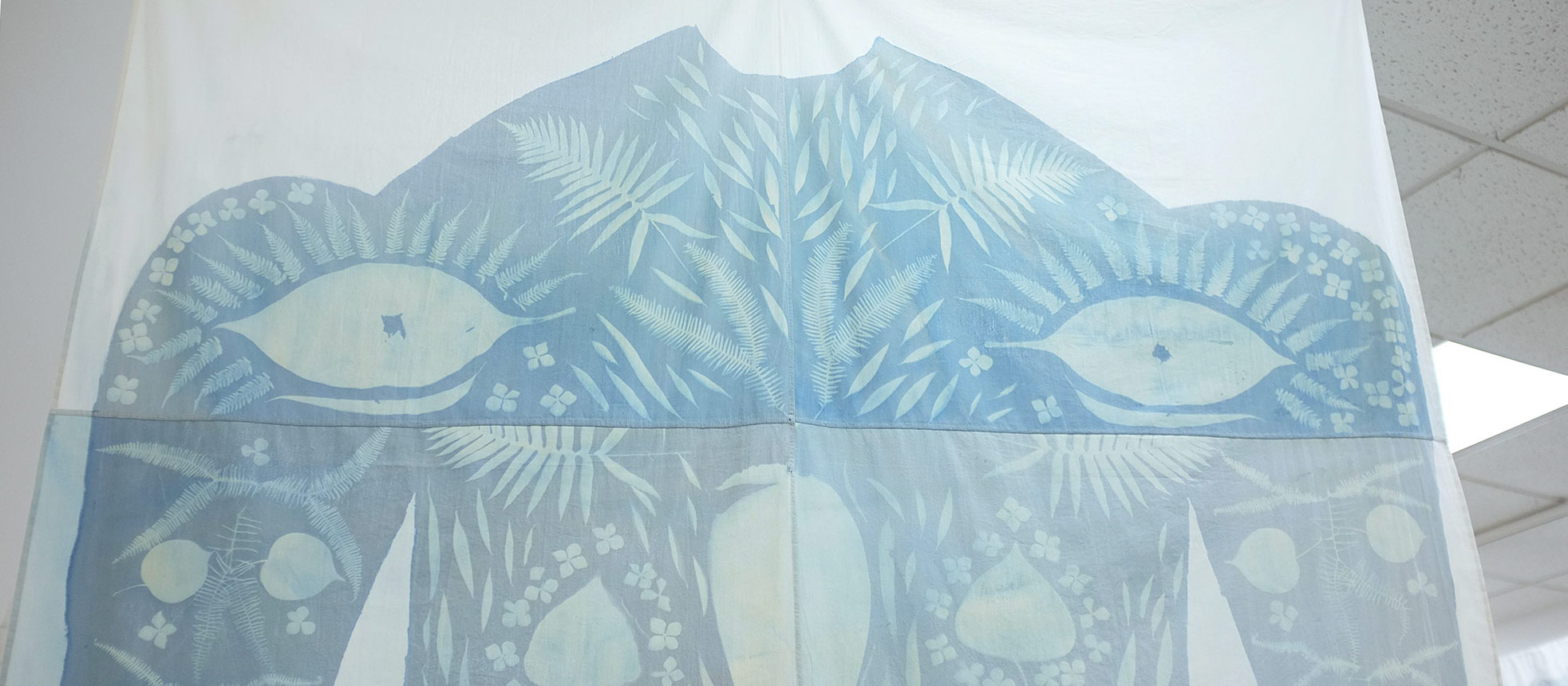MASHA LAMZINA
'I AM THE FOREST'
Cyanotype on textile. Online/Offline exhibition, installation. ‘Arka’ Gallery, Vladivostok. May 2020.
Fiber art is in a borderline position. On the one hand, it is often considered no more than a modern interpretation of traditional crafts. Thus, modernist critics denied it the status of a full-fledged, serious and ‘high’ art, attributing it to the applied arts. Works in which fabrics and threads were used as the main artistic materials were attributed ‘decorative’ in contrast to the ‘conceptuality’ of painting and sculpture. Also popular was the notion of textile art as gendered, growing out of ‘women’s hobbies’, which, in turn, are functional, which is unacceptable for an object of ‘true’ art.
Meanwhile, textile art was already in the scope of Bauhaus, one of the most important educational communities of the 20th century, which determined the development of modernism. The history of installation, which emerged later, is also associated with textile materials. In general, many American, European and Asian authors, working in such key areas of the postwar period as pop art, process and conceptual art, environmental art e.t.c. used fabrics extensively. Today, any boundary separating ‘high’ and ‘low’, fine and applied arts is no longer legitimate, and it is not the medium, but the artist’s intention that is primary to the work.
Masha Lamzina holds the same position. Known in Vladivostok as a designer and an artist, she doesn’t separate these two roles for herself, being interested in both functional and conceptual sides of clothes. In the new exhibition she continues to explore how this utilitarian object becomes a work of art.
Audience familiar with Lamzina’s previous works will easily recognize the contrasting, bleached-like ornaments on the fabric of these costumes. The artist experiments with a new technique – cyanotype, which is a photographic printing process: it is enough to cover a surface with a reagent and expose it in the direct sunlight in order to get an intense color. The image appears due to the placing of various objects on top of the fabric and thus creating shadows. In this case, these are grass, leaves and fruits collected in different climate zones, from Australian rainforests to Vladivostok.
Compared to Lamzina’s usual labor-consuming chlorine bleaching, where each detail is handmade, the cyanotype technique seems less tricky. However, it is this ‘non-interference’ in the process of making prints, triggered but not fully controlled by the author, that achieves the maximum precision, and for the natural forms and processes – to manifest themselves.
Clothing is a common and understandable object. Its properties are accepted by us as given, but Lamzina seeks to discover other possibilities, overcoming the limitations imposed on it by the human body. Thus, in one of her previous exhibitions, she presented clothes on a hypertrophied scale that have lost their functionality. In the new exhibition she goes further: suits and jackets of bizarre Victorian shapes cannot even be tried on – not so much because they are disproportionate to the body, but primarily because they are images of the clothes, objects-carriers of its very idea.
Moreover, some of them acquire an independent essence and their own ‘faces’, like in a game of imagination, where you glance at the thickets and accidentally catch those forms and ‘faces’. Researcher of visuality, James Elkins notes human ability to find faces in objects of the surrounding world (he calls it ‘the abstract machine of faciality’). An object perceived as a face ‘has the irresistible, unconditional attraction: [it] acts, [it] communicates something’. Personified by this ‘faciality machine’, the inanimate body speaks to the viewer as the object of observation or the recipient of its message.
The gaze ‘from the forest’ is also reminiscent of ritual masks. Lamzina is interested in shamanism as a way of returning to a natural state, a consciousness without the dualism of natural and human, mind and body. Primitivism, which the artist seeks – both in his views and in the means of work – allows her to realize herself as a part, not as the opposite, and, like the shaman during the ritual, to lose his identity in unity with nature. “I am the Forest” equates the actions of nature and men, challenging the very idea of their opposition.
Adel Kim, art historian, curator



































